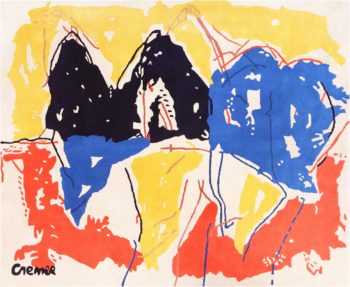Jan Cremer Rugs
View our current vintage collection of Jan Cremer art rugs below:
Vintage Yellow Black Red Blue Artist Jan Cremer Art Rug 49943
$14,500.00Size: 8 ft 1 in x 6 ft 7 in (2.46 m x 2.01 m)
Learn More About Vintage Jan Cremer Rugs and Carpet Collection
View our entire collection of art rugs and carpets by famous artists
“I observe and am invisible.” The essence of Jan Cremer, the acknowledgement of himself, is found in this statement. He is a man whose wanderlust has taken him to many places making him everywhere present, while hidden in plain sight.
Jan Cremer, born April 20, 1940 in Enschede, Netherlands at the start of the Second World War is many things. He is a graphic artist and painter, a self described globe trotting journalist, a planetary reporter, and a writer of international renown. His humble beginnings, however, might have suggested otherwise.
At the age of two his father died; three years later he is taken from his mother and made a ward of the state. His life became a series of foster homes and families from which he often ran away.
Out of that unimaginable existence came a major artistic talent who literally owes his life to art. It has been said that art, both written and painted, was a “life raft” for this war orphan who was also a young rogue with an insatiable desire to learn.
In 1964 when he was just twenty four years old, Cremer published a rather salacious autobiography titled “I Jan Cremer”. The I Jan Cremer autobiography catapulted him into the public limelight and spotlight. Cremer’s provocative writing, his chaotic lifestyle, and his beautiful and meaningful paintings caused the world to take pause and gaze upon that which had once been unnoticed.
Cremer has an exceptional eye for graphic art. This was apparent even at the tender age of fifteen while a student of Johan Haandra. In his first linocut, (a design or form carved in relief on a block of linoleum) Women with Sword his exceptional talent was obvious.
Cremer’s rough life style introduced him to a lot of artists and artistic styles one of which was the work of Karel Appel. Appel was an early influence in Cremer’s life opening for him an entirely new creative world. In 1955 in Rotterdam while Appel worked on his famous E55 (Expo) murals, Cremer had the dubious honor of handing the master his paintbrushes. That may seem insignificant to many, but it was while there, that the influence of Appel showed up in the art works of Cremer in the form of birds and cats. It was here that the red color became the dominant color in his work.
Another influence in Cremer’s life was his friendship with Frank O’Hara. O’Hara was a poet who also worked as a curator at the Museum of Modern Art. The two met in Amsterdam where O’Hara was mounting an art exhibition of the works of Franz Kline.
Cremer spent several days in O’Hara’s company often quoting him in the Haagse Post. Their friendship grew, and as a testament to Cremer’s artistic talent and their friendship, O’Hara chose a series of gouache paintings (a method of painting using opaque pigments ground in water and thickened with a glue like substance), from Cremer’s studio and wrote ten poems for them.
The sudden and tragic death of Frank O’Hara in 1966 devastated Cremer. Several years later Cremer, produces a series of screen prints that celebrated the New York Dutch landscape and the Dutch masters.
Reminiscing about his friend moved Cremer into a different place. It was during this time that he began to paint as if telling a story about Holland, evoking memories of his past, from the magnificent Land of Tulips.
In 1965 Jan’s first field of tulips is introduced to the modern art world. His stylized flowers, tulips in the shape of a heart blooming up towards a vivid blue color of the empty sky. This symbol, the tulips and hearts has become the leitmotif of Cremer’s life and style.

